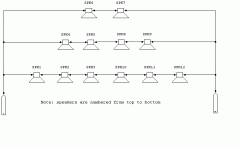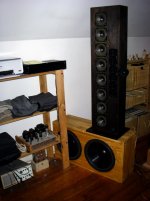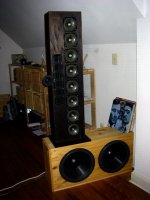Xlr8, One little suggestion if you are planning to put the project into reality. Try to connect everything up an listen to it before putting a back on the enclosure. Also, listen with a small amount of packing and without. You will find that these three things make a major difference in the sound.
I have found that my arrays will produce strong low frequency sound if it is just a single instrument, like a bass string instrument or organ. Add a major amount of bass from hard rock music and things get messed up fast. They also seem to prefer being listened too on the loud side. Nice quiet background music does not work. My interpretation of my own speakers!!! Your tastes may be different.
I think these units should be treated like long planar ribbons and not subjected to frequency below 400-500 hz. When it comes to low end --- nothing beats a big bass woofer or 2 or 3.
Just my two cents. Have fun you will be pleasantly surprised when they are complete. Tad
I hope you have a couple hundred watts to use per channel!!!
I have found that my arrays will produce strong low frequency sound if it is just a single instrument, like a bass string instrument or organ. Add a major amount of bass from hard rock music and things get messed up fast. They also seem to prefer being listened too on the loud side. Nice quiet background music does not work. My interpretation of my own speakers!!! Your tastes may be different.
I think these units should be treated like long planar ribbons and not subjected to frequency below 400-500 hz. When it comes to low end --- nothing beats a big bass woofer or 2 or 3.
Just my two cents. Have fun you will be pleasantly surprised when they are complete. Tad
I hope you have a couple hundred watts to use per channel!!!
Did the same sort of calculation and came up with a nominal impedence of 8ohms for 16 drivers as opossed to 20. Never attempted to calculate so many drivers before.
Xlr8, have you looked at power tapering? You can arrive at different impedances than usual series/parallel wireing.
Attachments
I'd be tempted to start by using the XO already in the maggies.
well, they're gone. Replaced by DBX 234 active crossover set at around 3khz. The user manual says this it the stock point, but a fellow named AndyR at a site called "Mug Tweaks" has found that the stock crossovers actually have 2 crossover points which divide the mid from the tweet. He says one is LP around 2.5khz and the other is HP around 4khz. I basically just split the difference @ 3khz.
Xlr8, One little suggestion if you are planning to put the project into reality. Try to connect everything up an listen to it before putting a back on the enclosure. Also, listen with a small amount of packing and without. You will find that these three things make a major difference in the sound.
Hey, how'd you get inside my head??
 That is almost exactly what I was thinking.
That is almost exactly what I was thinking. Xlr8, have you looked at power tapering? You can arrive at different impedances than usual series/parallel wireing.
I have not taken a hard look at this yet, but I will.
Thanks again to everyone!!
adason,
According to your attatched digram, if I'm using 8ohm drivers, I should arrive at 4ohms total. Is this correct?
According to your attatched digram, if I'm using 8ohm drivers, I should arrive at 4ohms total. Is this correct?
According to your attatched digram, if I'm using 8ohm drivers, I should arrive at 4ohms total. Is this correct?
Hi xlr8,
according to my calculations, its 8.72 ohm, if you use 8 ohm speakers in the attached diagram
this is how I do it:
two 8 ohm speakers on top in series is 16 ohms
four in lower row is 32 ohms
six in series in third row gives 48 ohms
put all resulting impedances in parallel:
1/R = 1/16 + 1/32 + 1/48
1/R = 0.11458
therefore R = 8.72 ohm
The graph above was just for ilustration, you do not have to use 12 drivers, I was just suggesting to use power tapering. If you are going to use power tapering, note the numbering of the drivers and their position in line array. It's important.
amplifiers like high impedance, the higher the impedance the less current and it means less distortion, Nelson Pass' opinion , not mine
I fully agree with that! however....
wire them all in series!
20 speakers each 8 ohms in series is 160 ohm, the amp might like it, but you will not, since it will be very quiet with normal amp. You would have to have either step up trafo to have higher voltage swing or OTL amp or some other way to power it. Otherwise such speakers would only work as giant headphones, which in case of line array is not practical. Nothing wrong with going high impedance route as long as you have amp to power it.
adason said:
however....
20 speakers each 8 ohms in series is 160 ohm, the amp might like it, but you will not, since it will be very quiet with normal amp
not necessarily IMHO
well, after all - what is a normal amp?
and what is very quiet?
wiring drivers in series means less voltage sensitivity dB/V
but it also means a gain in power efficiency dB/W
in case of 20 drivers it is more than 12 dB
let's assume that a 100W/8 Ohm amp is a quite normal HiFi amp
100W means that it is capable of around 28 Volt into 8 Ohm load
those same 28V means 5W into 160 Ohm load
let's assume that we have an array of drivers of 84 dB/W nominal efficiency, typical for small fullrangers
in that situation we have an array of more than 96 dB/W nominal efficiency
we loose some of it in the result of equalization necessary for lifting up of the highs, let's assume that with suitable drivers this loss is around 6 dB
We end up with an array of 90 dB/W nominal efficiency and above 95 dB/5W max spl
perhaps for some or even many people it is quiet but certainly not for everybody
on the other hand there are suitable drivers of more than 84 dB/W efficiency and many amps of more than 100W of power
if You would like to discuss the "SPL target" question I invite You to this thread: http://www.diyaudio.com/forums/showthread.php?s=&threadid=121893
on the other hand You are quite right - of course when I was thinking of wiring in series I was indeed thinking about optimal load for an OTL amp which is best option in such a case
best,
graaf
It seems to me that our discussion is going a little bit OT
Let's continue if You wish in the original "100 Ohm loudspeaker" thread at the" Tubes": http://www.diyaudio.com/forums/showthread.php?s=&threadid=110164
best,
graaf
Let's continue if You wish in the original "100 Ohm loudspeaker" thread at the" Tubes": http://www.diyaudio.com/forums/showthread.php?s=&threadid=110164
best,
graaf
let's assume that a 100W/8 Ohm amp is a quite normal HiFi amp 100W means that it is capable of around 28 Volt into 8 Ohm load those same 28V means 5W into 160 Ohm load
that is all ok only in theory
if you have 100 watts amp, you never operate it at 100 watts, especially with music, if you need to you are in lot of troubles
if with music peaks reach 100 watts, so you barely clipping, than on average it may be only few watts, maybe few tens of watts
your theoretical 5 watts into 160 ohm may play on average music signal just half the watt
than maybe enough loudness for small room, but not much headroom
anyway, just the thought
well, after all - what is a normal amp?
you know, 99% of amplifiers outhere, classAB, complementary output topology, 50-100 watts, you know what I mean
and what is very quiet?
something you can barely hear, for me anyway
adason said:that is all ok only in theory
(...)
maybe enough loudness for small room, but not much headroom
well, I agree - "not much" headroom in the specific example given above BUT from "not much headroom" follows only "not much headroom" and not "that is all ok only in theory" 🙂
non sequitur
therefore I disagree with the statement: "that is all ok only in theory"
adason said:
you know, 99% of amplifiers outhere, classAB, complementary output topology, 50-100 watts, you know what I mean
something you can barely hear, for me anyway
I agree 🙂
best,
graaf
It seems to me that our discussion is going a little bit OT
I know its not the topic of this thread... I have OTL amp. I love it. But its just 2 watts! It can drive 4 ohm speakers, but sounds best with 8-16 ohms high efficiency speakers. With 18" Cervin Vega, Radian 805 midrange horn and Cervin Vega horn tweeter, all above 100dB/w/m can shake the house. Most of the listening is done with 100-300 miliWatts.
Personaly I am not into high impedance speakers, seems that it offers less flexibility. I love swapping amps and speakers. I have way too many of them and its too much fun.
I have always been fascinated by the idea of several speakers sharing the load. After seeing and reading what some write about line arrays I had to build one. I had previously bought 11 Tb w4 1052s and decided I would use those. The first question what format one speaker to test mono. Way to much work especially if it sucked and most likely i'd be fascinated in mono and then have to build the second one before I discovered they weren't the cat's meow. So I decided to build a miniture version of the RBH T system
I know the guys from back when I used to sell their stuff and know their stuff always sounds fantastic. So I laid out a arched midbass arrangement according to pure ease of measurements and aesthetics. With the remaining space for a tweeter I figured out what the maximum flange size of the tweeter could be and still be on the same horizontal axis as the top and bottom woofers as well as what the sensitivity should be so that I didn't have to pad it down (I had hoped anyway) and picked out a tweeter. Then my local tangband distributor talked me into a different tweeter (a vifa oem product you can see it here with more sensitivity. Calculated a bass reflex box with WinIsd with all four midbasses in one enclosure wired parallel series. Off I went.
They sounded awesome a little bright but awesome. The crossover is designed to be just over where the CTC spacing would cause lobing. 3500 or 4000Hz I can't even remember. totally theoretical 2nd order crossover. So i had them measured and the tweeter was a little bright and there was a slight dip at the crossover point but nothing to severe dips are less perceivable anyway. All in all they sound awesome. And as the others hear will tell you I broke tons of design rules in the process, but they still sound better than a kit design I built. I love them. Even though I liked the prototype cabinets I decided to make the final version a floorstander with 50% more volume the prototype had them squished in the minimal space for my decided minimum low end frequency. Like them even better now. So my lesson was design and build then enjoy. With MCM, HiVi and TangBand it is fairly cheap to experiment. And to be honest it is really the only way to learn this stuff.
I know the guys from back when I used to sell their stuff and know their stuff always sounds fantastic. So I laid out a arched midbass arrangement according to pure ease of measurements and aesthetics. With the remaining space for a tweeter I figured out what the maximum flange size of the tweeter could be and still be on the same horizontal axis as the top and bottom woofers as well as what the sensitivity should be so that I didn't have to pad it down (I had hoped anyway) and picked out a tweeter. Then my local tangband distributor talked me into a different tweeter (a vifa oem product you can see it here with more sensitivity. Calculated a bass reflex box with WinIsd with all four midbasses in one enclosure wired parallel series. Off I went.
They sounded awesome a little bright but awesome. The crossover is designed to be just over where the CTC spacing would cause lobing. 3500 or 4000Hz I can't even remember. totally theoretical 2nd order crossover. So i had them measured and the tweeter was a little bright and there was a slight dip at the crossover point but nothing to severe dips are less perceivable anyway. All in all they sound awesome. And as the others hear will tell you I broke tons of design rules in the process, but they still sound better than a kit design I built. I love them. Even though I liked the prototype cabinets I decided to make the final version a floorstander with 50% more volume the prototype had them squished in the minimal space for my decided minimum low end frequency. Like them even better now. So my lesson was design and build then enjoy. With MCM, HiVi and TangBand it is fairly cheap to experiment. And to be honest it is really the only way to learn this stuff.
flaevor
Just do it. If you had followed all the technical stuff you would have not made that decision -- I suppose.
How about some picks of the completed units.
I am not endorsing the idea that everyone go shoot a couple of grant all to pieces to prove something. In many cases the cash outlay is not to terribly impressive and you get to have fun while experimenting. I am glad your endeavor was successful as was mine. Tad
Just do it. If you had followed all the technical stuff you would have not made that decision -- I suppose.
How about some picks of the completed units.
I am not endorsing the idea that everyone go shoot a couple of grant all to pieces to prove something. In many cases the cash outlay is not to terribly impressive and you get to have fun while experimenting. I am glad your endeavor was successful as was mine. Tad
I should post some picks, I'll get around to it here soon.
My point is people should read stuff and then try it for themselves if they really want to learn. I think a coax line array won't work well because of the lobing issues, but I have also read somewhere that due to all of the reflections the lobing becomes less of a factor. Thus I say build and try. There are so many designs that most of us would say can't work yet they sound good. I personally think you could build an array of 3" or 4" drivers and just add an efficient tweeter that can keep up and you'll be very very happy. Speakers you are proud of always sound better anyway. 😉
My point is people should read stuff and then try it for themselves if they really want to learn. I think a coax line array won't work well because of the lobing issues, but I have also read somewhere that due to all of the reflections the lobing becomes less of a factor. Thus I say build and try. There are so many designs that most of us would say can't work yet they sound good. I personally think you could build an array of 3" or 4" drivers and just add an efficient tweeter that can keep up and you'll be very very happy. Speakers you are proud of always sound better anyway. 😉
adason said:
20 speakers each 8 ohms in series is 160 ohm
160 ohm nominal
but what actual ? what about "The Dynamical Loudspeaker Impedance"?
see: http://www.audiograph.se/subpages/technical/whatmakesagoodamplifier.htm
Does the amplifier "see" those 160 ohm or rather only 40 ohm or so? I don't know
in order not to start another OT in this thread I have started a new thread at the "Loudspeakers"
best,
graaf
- Status
- Not open for further replies.
- Home
- Loudspeakers
- Full Range
- Line array with coaxial drivers


